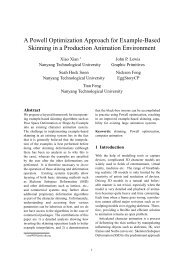Real-Time Weighted Pose-Space Deformation on the GPU
Real-Time Weighted Pose-Space Deformation on the GPU
Real-Time Weighted Pose-Space Deformation on the GPU
Create successful ePaper yourself
Turn your PDF publications into a flip-book with our unique Google optimized e-Paper software.
T. Rhee, J.P. Lewis, and U. Neumann / EG 2006<br />
weights for each vertex are automatically computed from <strong>the</strong><br />
sample poses. This can enhance <strong>the</strong> skinning quality not <strong>on</strong>ly<br />
of SSD but also WPSD, since both methods require accurate<br />
joint weight values.<br />
The deformati<strong>on</strong> required in WPSD and SSD is independent<br />
for each vertex and this per-vertex computati<strong>on</strong> can be<br />
parallelized in a SIMD architecture. The <strong>GPU</strong> is a general<br />
SIMD architecture having <strong>on</strong>e-sided (unidirecti<strong>on</strong>al) communicati<strong>on</strong><br />
to texture memory. We dem<strong>on</strong>strate our parallel<br />
WPSD method using <strong>GPU</strong> fragment processors. In our experiments,<br />
we can speed up SSD, PSD, as well as WPSD<br />
to around 20 times faster than <strong>on</strong> <strong>the</strong> CPU (from 1.2FPS to<br />
25FPS speed-up of WPSD <strong>on</strong> a detailed model having 22836<br />
triangles with 11574 vertices) using a modern graphics card,<br />
thus making WPSD a feasible real-time skinning soluti<strong>on</strong><br />
for various applicati<strong>on</strong>s including games, virtual reality, and<br />
o<strong>the</strong>r real-time simulati<strong>on</strong>s.<br />
2. Related work<br />
Many commercial software packages generate skin deformati<strong>on</strong><br />
arising from joint movement using a method known<br />
as (linear blend) skinning, Skeletal Subspace <str<strong>on</strong>g>Deformati<strong>on</strong></str<strong>on</strong>g><br />
(SSD), enveloping, etc., based in part <strong>on</strong> work published by<br />
Thalmann et al. [MTLT88]. SSD is based <strong>on</strong> <strong>the</strong> weighted<br />
blending of affine transformati<strong>on</strong>s of each joint and used in<br />
many real-time applicati<strong>on</strong>s due to its simple and fast computati<strong>on</strong>.<br />
However, it also exhibits some well known artifacts<br />
such as skin that collapses around <strong>the</strong> joints at increasing<br />
bend angles, and a variety of soluti<strong>on</strong>s for <strong>the</strong>se problems<br />
have been published [Web00, WP02, MTG03, KZ05].<br />
Recently, example-based methods [LCF00, SRC01,<br />
ACP02, KJP02, KM04] have permitted more complex<br />
skinning effects such as muscle bulges and major wrinkles,<br />
while also addressing <strong>the</strong> artifacts of simple algorithmic<br />
schemes. In <strong>the</strong>se methods, a number of provided (scanned<br />
or sculpted) samples of <strong>the</strong> desired skin shape are simply<br />
interpolated based <strong>on</strong> <strong>the</strong> creature’s pose (and possibly additi<strong>on</strong>al<br />
abstract c<strong>on</strong>trol “dimensi<strong>on</strong>s”). These example-based<br />
methods can also be c<strong>on</strong>sidered as a n<strong>on</strong>-parametric approach<br />
to skin deformati<strong>on</strong>. In comm<strong>on</strong> with n<strong>on</strong>-parametric<br />
sampling methods in texture syn<strong>the</strong>sis (and more generally<br />
in statistical regressi<strong>on</strong>), <strong>the</strong> amount of memory for <strong>the</strong>se<br />
methods grows with <strong>the</strong> number of training samples, but<br />
arbitrary distributi<strong>on</strong>s can be approximated.<br />
Some of <strong>the</strong> most impressive example-based results to<br />
date are those of Kurihara and Miyata’s hand model derived<br />
from medical images [KM04]. Since acquiring 3D medical<br />
images is relatively expensive, <strong>the</strong>y developed weighted<br />
pose space deformati<strong>on</strong> (WPSD) to generate proper skinning<br />
from a limited number of pose samples. They modify <strong>the</strong> distance<br />
between poses using <strong>the</strong> joint weights of each vertex to<br />
provide a more appropriate distance measure for skinning.<br />
Although <strong>the</strong> joint weights for each vertex are important<br />
data for SSD and WPSD calculati<strong>on</strong>s, <strong>the</strong>y have traditi<strong>on</strong>ally<br />
been manually generated by skilled artists. Least-squares<br />
based vertex weight estimati<strong>on</strong> was shown in <strong>the</strong> skinning<br />
methods [WP02, MTG03]. James et al. describe mesh based<br />
skinning including estimati<strong>on</strong> of b<strong>on</strong>e parameters and vertex<br />
weights for each b<strong>on</strong>e [JT05]. In <strong>the</strong>ir paper, <strong>the</strong> vertex<br />
weights of each joint are calculated by NNLS (n<strong>on</strong>-negative<br />
least squares) and we derive a similar approach to calculate<br />
weights for SSD and WPSD.<br />
In recent years, since <strong>the</strong> performance of <strong>GPU</strong>s has been<br />
improving more rapidly than that of CPUs, and <strong>GPU</strong>s have<br />
many processing units serving as a SIMD parallel architecture,<br />
many algorithms have been accelerated by <strong>GPU</strong> programming<br />
[LHK ∗ 04, PF05, GPG]. <str<strong>on</strong>g>Deformati<strong>on</strong></str<strong>on</strong>g> and skinning<br />
algorithms can also be enhanced by <strong>GPU</strong>s and several<br />
papers have profited from this [JP02, KJP02, BK05, JT05].<br />
However, in previous research, since vertex informati<strong>on</strong><br />
cannot be accessed in <strong>the</strong> fragment program, <strong>GPU</strong>-based<br />
vertex deformati<strong>on</strong> is usually performed by vertex programs.<br />
In this paper, we develop a parallel WPSD method using <strong>the</strong><br />
fragment processors to gain greater parallelism and performance.<br />
Pers<strong>on</strong>-specific data modeling and its deformati<strong>on</strong> is also<br />
an interesting topic in realistic articulated body simulati<strong>on</strong>.<br />
Rhee et al. described human hand modeling from surface<br />
anatomy of <strong>the</strong> pers<strong>on</strong> [RNL06]. Anguelov et al. developed<br />
shape completi<strong>on</strong> and animati<strong>on</strong> of people, derived from <strong>the</strong><br />
set of range scan data and example based deformati<strong>on</strong> in<br />
pose and shape space [ASK ∗ 05].<br />
Physically inspired skinning should be also recognized as<br />
ano<strong>the</strong>r important area of articulated body animati<strong>on</strong>. However,<br />
we entrust <strong>the</strong> review of <strong>the</strong> subject to <strong>the</strong> recent related<br />
papers [AHS03, CBC ∗ 05, PCLS05, SNF05].<br />
3. Skin deformati<strong>on</strong><br />
Example-based skinning problems can be described by <strong>the</strong><br />
following general equati<strong>on</strong>,<br />
v(p a)=S(v 0 + D(p a)) (1)<br />
where p a is an arbitrary pose, v(p a) is a vertex of a deformed<br />
target surface of <strong>the</strong> arbitrary pose, v 0 is an undeformed<br />
(rest pose) vertex, S is <strong>the</strong> SSD functi<strong>on</strong>, and D(p a)<br />
is a displacement as a functi<strong>on</strong> of <strong>the</strong> arbitrary pose.<br />
In skeletal subspace deformati<strong>on</strong> <strong>the</strong> displacement D(p a)<br />
is omitted and <strong>the</strong> target surface is calculated by SSD as<br />
a blend of affine transforms of v 0 [secti<strong>on</strong> 3.1]. Skinning<br />
methods related to PSD use <strong>the</strong> displacement of an arbitrary<br />
pose D(p a), calculated by interpolati<strong>on</strong> in pose space [secti<strong>on</strong><br />
3.2].<br />
c○ The Eurographics Associati<strong>on</strong> and Blackwell Publishing 2006.







